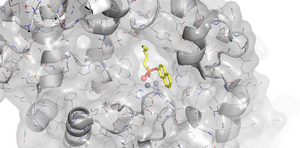Chemical weaponsEnzymes versus nerve agents: Designing antidotes for chemical weapons
Nerve agents, a class of synthetic phosphorous-containing compounds, are among the most toxic substances known. Brief exposure to the most potent variants can lead to death within minutes. Once nerve agents enter the body, they irreversibly inhibit a vitally important enzyme called acetylcholinesterase. Its normal job within the nervous system is to help brain and muscle communicate. When a nerve agent shuts down this enzyme, classes of neurons throughout the central and peripheral nervous systems quickly get overstimulated, leading to profuse sweating, convulsions and an excruciating death by asphyxiation. There is a path to mitigate the danger of chemical weapons. This route lies within the domains of science – the very same science that produced chemical weapons in the first place. Researchers in the United States and around the world are developing the tools needed to quickly and safely destroy nerve agents – both in storage facilities and in the human body. There are promising advances, but no enzyme yet exists which is efficient enough for lifesaving use in people. It is worth keeping in mind the awesome and often complex power of science, however: We may be only a few years away from developing the kind of therapeutics that would make chemical weapons a worry of the past.

Enzymes can engulf and break down hundreds of nerve agent molecules per second // Source: theconversation.com
A chemical weapons attack that killed more than 80 people, including children, triggered the Trump administration’s recent missile strikes against the Syrian government. The use of illegal nerve agents – apparently by the Assad regime – violated international law; President Trump said he was moved to act by images of the victims’ horrible deaths.
But there’s another path to mitigate the danger of chemical weapons. This route lies within the domains of science – the very same science that produced chemical weapons in the first place. Researchers in the U.S. and around the world, including here at the University of Washington’s Institute for Protein Design, are developing the tools needed to quickly and safely destroy nerve agents – both in storage facilities and in the human body.
Nerve agents, a class of synthetic phosphorous-containing compounds, are among the most toxic substances known. Brief exposure to the most potent variants can lead to death within minutes. Once nerve agents enter the body, they irreversibly inhibit a vitally important enzyme called acetylcholinesterase. Its normal job within the nervous system is to help brain and muscle communicate. When a nerve agent shuts down this enzyme, classes of neurons throughout the central and peripheral nervous systems quickly get overstimulated, leading to profuse sweating, convulsions and an excruciating death by asphyxiation.
Chemical weapons are often associated with wars of the previous century – mustard gas in WWI, Zyklon B in WWII. But the worst variety, nerve agents, were never deployed in the world wars, though Nazi scientists developed the first generation of these compounds. Gerhard Schrader, the so-called father of nerve agents, didn’t begin life as a Nazi scientist – he was developing new pesticides to combat world hunger when he accidentally synthesized the first organophosphorus nerve agent. Later, he led the research team that produced sarin, or GB, the most toxic of the all the so-called G-series nerve agents. The U.S. government stated with “very high confidence” that sarin was used in the recent attack near Idlib, Syria.
